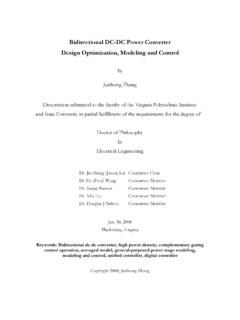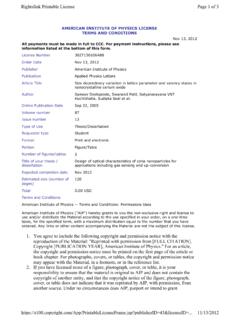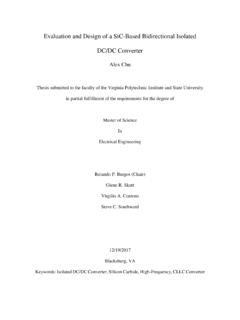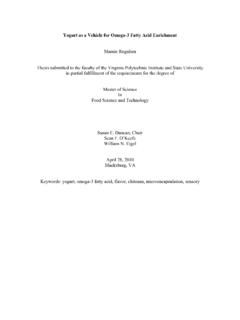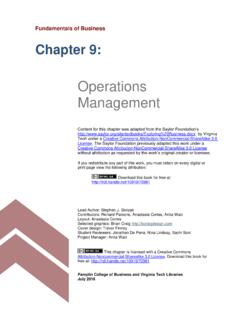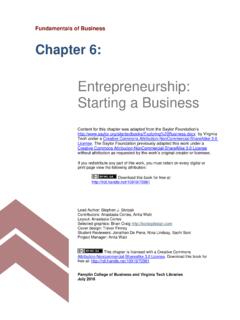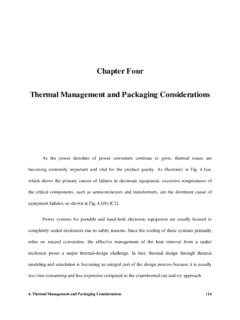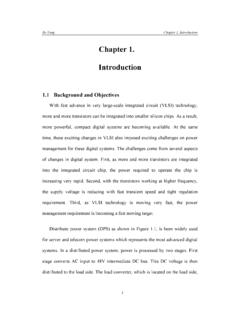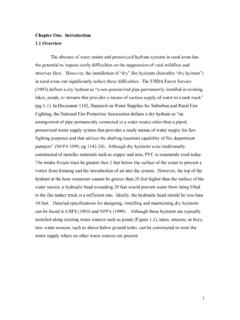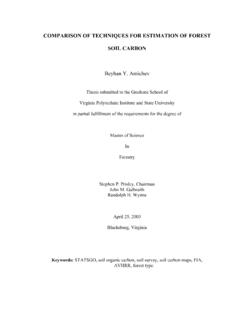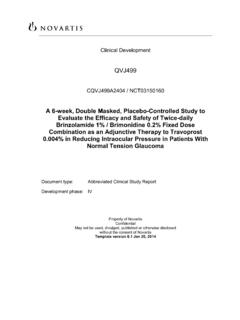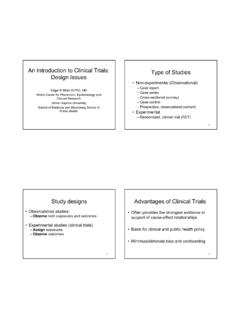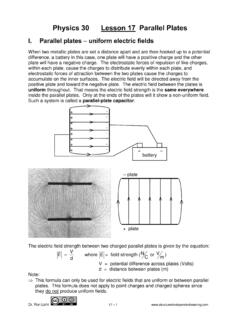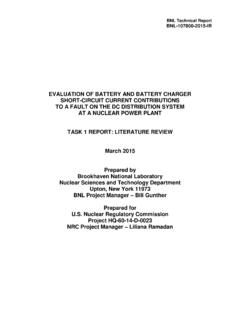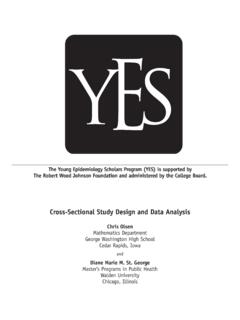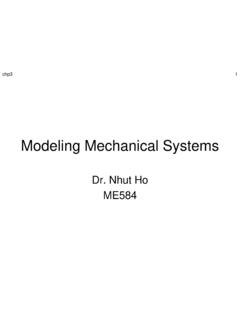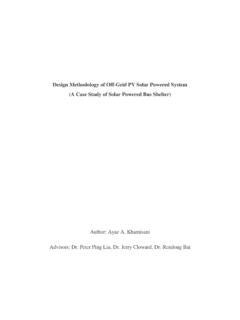Transcription of Implementation of Design Failure Modes and Effects ...
1 Copyright 2016, Lucas Wayne Shoults Implementation of Design Failure Modes and Effects Analysis for Hybrid Vehicle Systems Lucas Wayne Shoults Thesis submitted to the faculty of the Virginia Polytechnic Institute and State University in partial fulfillment of the requirements for the degree of Master of Science In Mechanical Engineering Chair: Douglas J. Nelson Scott T. Huxtable Robert L. West May 02, 2016 Blacksburg, VA Keywords: hybrid electric vehicle, risk management, Failure Modes and Effects analysis, customer requirements, electric motor system Implementation of Design Failure Modes and Effects Analysis for Hybrid Vehicle Systems Lucas Wayne Shoults ACADEMIC ABSTRACT An increase emphasis has been placed on the automotive industry to develop advanced technology vehicles which meet increasing strict government regulations and standards for emissions and fuel economy while maintaining the safety, performance, and consumer appeal of the vehicle.
2 In response to these requirements, hybrid and electric vehicle technologies have become more complex as the necessity for vehicles with an overall better environmental impact. Modern engineers must understand the current methods used to analyze and evaluate risk with the new hybrid technologies to ensure the continued customer satisfaction and safety while meeting new government and agency standards. The primary goal of this work is to maintain consistent definitions, standards, and protocols for risk analysis using Design Failure Modes and Effects analysis. Throughout the entire automotive sector there exist standards for risk analysis and methods for analysis, however these models can be difficult to relate to the atmosphere under which educational competitions occur.
3 The motor system case study within this work aims to allow the process for DFMEA to be simple and easily implemented and understood when it is appropriate to start. After defining the model, an electric motor system for hybrid vehicle is analyzed for mechanical and inverter system risks. The end result being a 32% reduction in motor system risk due to recommended actions for mitigating top motor systems risks for future motor system Design and Implementation , all to meet customer requirements. This work aims to provide an additional tool that when implemented will accelerate the next generation of automotive engineers. iii Implementation of Design Failure Modes and Effects Analysis for Hybrid Vehicle Systems Lucas Wayne Shoults GENERAL PUBLIC ABSTRACT An increased emphasis has been placed on the automotive industry to develop advanced technology vehicles to meet rising strict government regulations and standards for emissions and fuel economy while maintaining the safety, performance, and consumer appeal of the vehicle.
4 As a result of the new legislation, complex systems for hybrid and electric vehicle technologies have been developed to improve fuel economy and reduce criteria tail pipe emissions. Modern engineers must understand the current methods used to analyze and evaluate risk with new hybrid technologies to ensure continued customer satisfaction and safety while meeting new government and agency standards. Throughout the entire automotive sector there exist standards and methods for risk analysis, however these models can be difficult to apply to student Design project. The student designed motor system case study within this work aims for DFMEA to be simple and easily implemented by students, increasing the educational experience.
5 After defining the model, a motor system for a hybrid vehicle is analyzed for mechanical and inverter system risks. The end results are the recommended actions for mitigating top motor systems risks for future motor system Design and Implementation , all to meet customer requirements and reduce system risks. This work provides an additional tool that when implemented will advance the educational experience for the next generation of automotive engineers. iv Acknowledgements First and foremost I would like to thank God for giving me the opportunity to pursue my Masters at Virginia Tech and His continued guidance in my life. I would also like to thank General Motors, the United States Department of Energy, and Argonne National Labs, for sponsoring and organizing the Advanced Vehicle Technology Competitions EcoCAR 2 and EcoCAR 3 which has provide me an unconventional and unparalleled graduate career here at Virginia Tech.
6 I would like to thank the Hybrid Electric Vehicle Team for the family that was formed and the amazing accomplishments we achieved together. The experiences and wisdom gained through my time on the team will carry me strongly into any future endeavor and engineering position. I would like to thank Dr. Nelson, for his dedication to the students, his ability to inspire those to challenge themselves, and for the friendship that was developed over my time under his leadership. Lastly, I would like to thank my brothers and sisters who have encouraged me throughout this process and to my beautiful bride-to-be Heidi, for her love, patience and constant prayer for God s plan in our life together. v Table of Contents Acknowledgements.
7 Iv Table of Contents .. v List of Multimedia Objects .. vii List of Tables .. vii List of Figures .. viii List of Terms & Abbreviations .. ix 1 Introduction .. 1 FMEA and Importance in Automotive Industry and Advanced Vehicle Technologies .. 1 Introduction to Types of FMEA .. 1 Systems FMEA .. 1 Design FMEA .. 2 Introduction to Parallel Plug-In Hybrid Electric Vehicles .. 3 EcoCAR 3: Advanced Technology Vehicle Competitions .. 4 Introduction .. 4 HEVT Team Structure .. 4 VDP .. 5 Summary .. 8 Application in EcoCAR 3 .. 8 2 Literature Review .. 10 Background and Application of 10 DFMEA in the Automotive Industry and Future Work .. 11 SAE J1739 development by the OEMs .. 12 Risk analysis is not easily and commonly incorporated.
8 13 A case study of FMEA in automotive vehicle applications .. 14 Summary of Literature Review .. 16 3 DFMEA Terminology, Team Theory, and Definitions .. 18 The DFMEA Team .. 18 FMEA Team Meeting Structure and FMEA Implementations .. 19 FMEA Team Meeting Structure .. 19 FMEA Implementation into the Vehicle Design Process .. 20 Defining the Customer .. 22 FMEA Naming and Numbering .. 22 DFMEA Column Descriptions .. 24 24 Part/Interface .. 25 Design Function .. 27 Potential Failure Mode .. 27 Potential Effects of Failure .. 27 Severity .. 28 Potential Cause/Mechanism of Failure .. 29 Occurrence .. 29 Current Design Controls Prevention Method .. 30 Current Design Controls Detection Method.
9 30 Detection .. 31 Risk Priority Number, Criticality Number, and Thresholds .. 32 Recommended Actions .. 33 4 Model Application .. 34 Motor Team Roles and Responsibilities .. 34 Motor System Customer Requirements .. 35 vi End User and Governing Organizations Requirements .. 35 Supplier Requirements .. 37 Internal Customer Requirements .. 38 FMEA Naming and Numbering .. 40 Motor System DFMEA Columns .. 40 Motor System Subsystems Identification .. 41 Motor System Parts and Interfaces .. 42 Motor System Design Functions .. 46 Motor System Potential Failure Modes .. 47 Motor System Effects of the Failure Modes .. 47 Motor System Severity Rankings .. 48 Motor System Potential Causes .. 49 Motor System Failure Mode Occurrence Ratings.
10 49 Motor System Failure Mode Prevention and Detection Methods .. 50 Motor System Failure Mode Detection Ratings .. 51 Motor System Risk Priority Numbers, Criticality Numbers, and Thresholds .. 51 Motor System Recommended Actions .. 54 5 Conclusion .. 57 Future Work .. 58 Summary .. 59 References .. 60 Appendix A: Mechanical Motor Design Requirements .. 61 Appendix B: Complete DFMEA .. 63 vii List of Multimedia Objects List of Tables Table 1-1: Team 6 Table 1-2: VTS .. 6 Table 3-1: Recommended meeting schedule for effective vehicle SFMEA .. 19 Table 3-2: Team Member Attendance Form Except .. 20 Table 3-3: Example FMEA Name and Number Convention for Energy Storage System 23 Table 3-4: Example FMEA Name and Number Convention for Energy Storage System 23 Table 3-5: Component Numbering.
